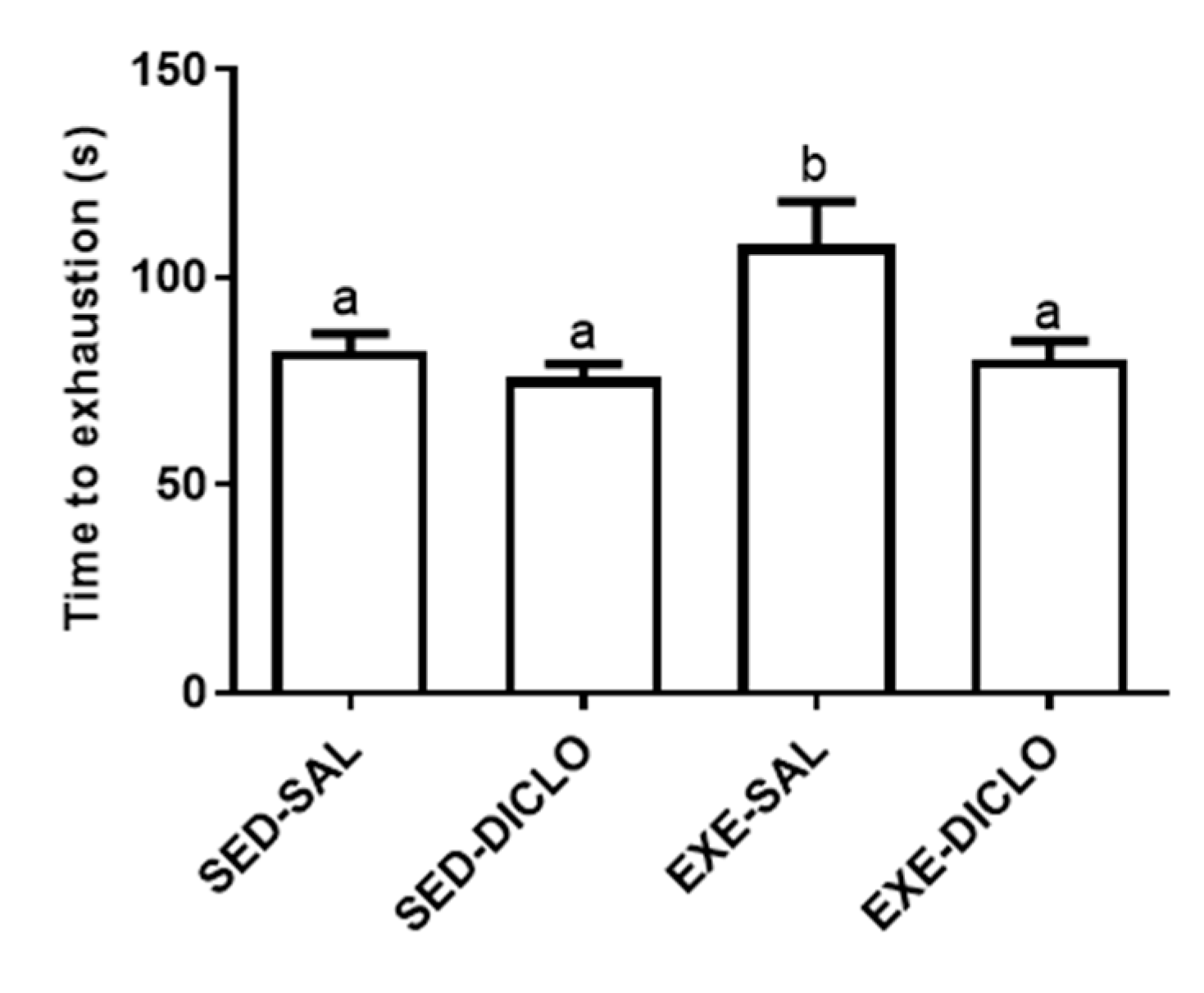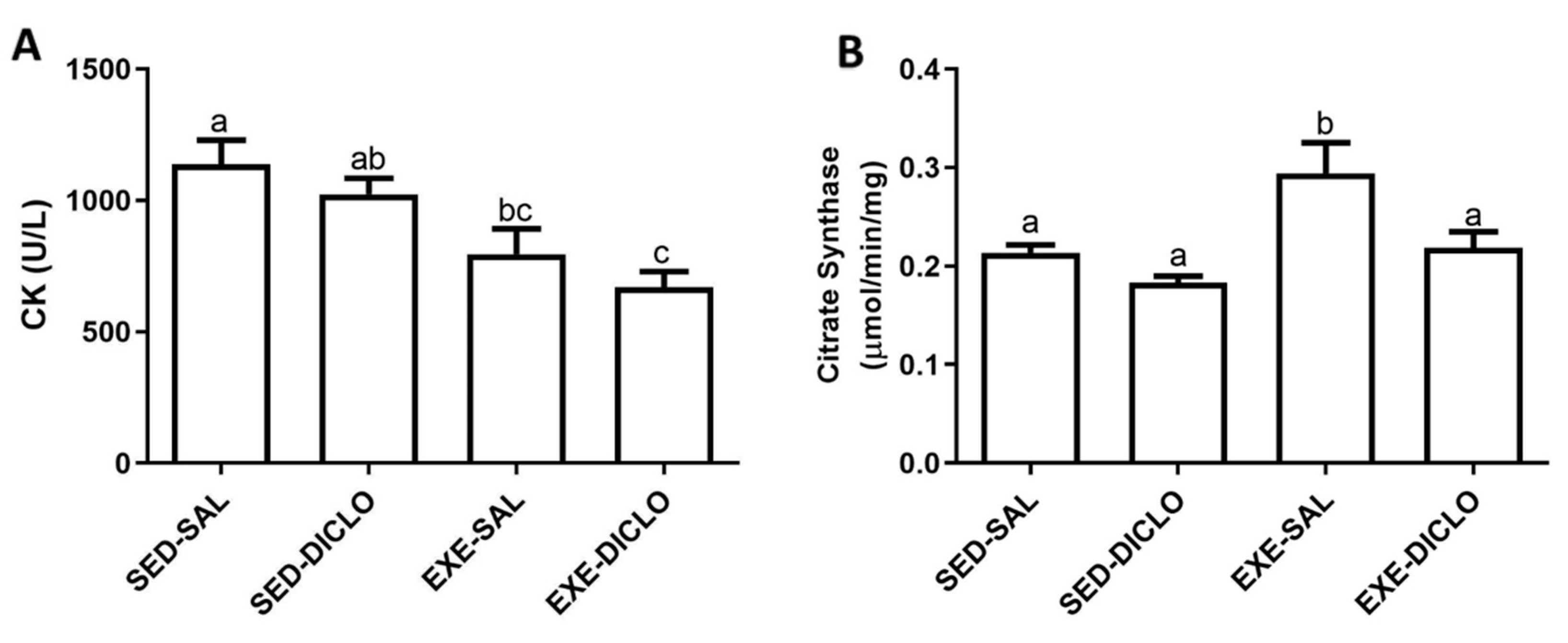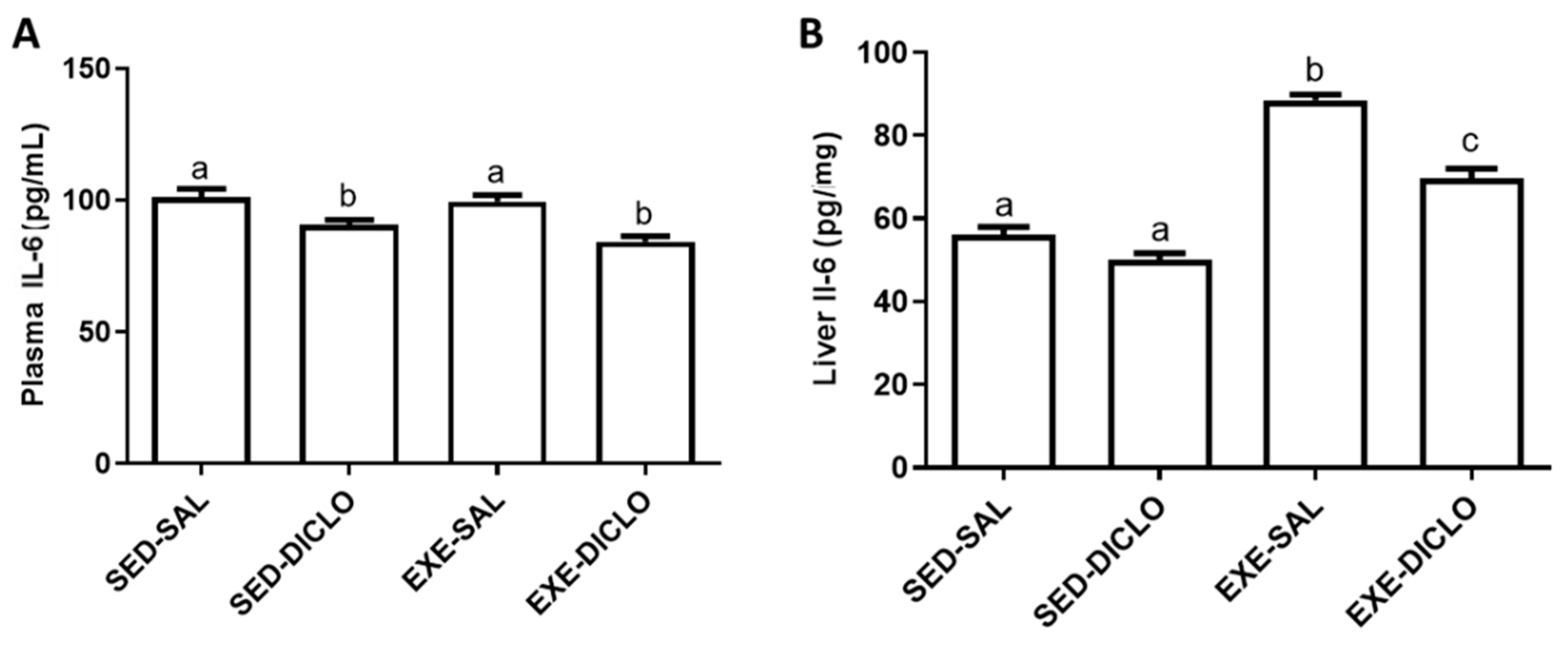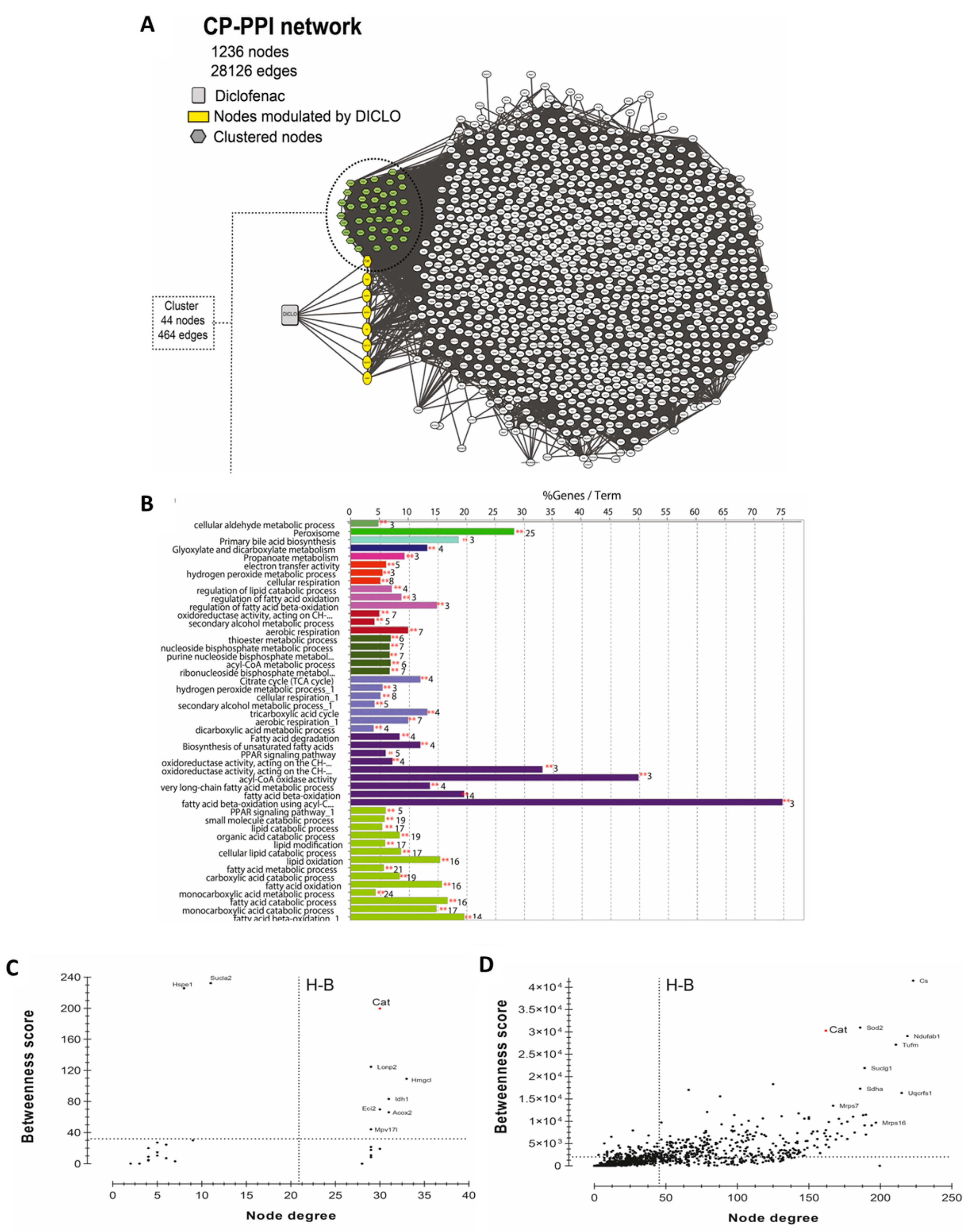Diclofenac Administration after Physical Training Blunts Adaptations of Peripheral Systems and Leads to Losses in Exercise Performance: In Vivo and In Silico Analyses
Abstract
:1. Introduction
2. Materials and Methods
2.1. Animals and Ethics Statement
2.2. Experimental Design and Diclofenac Administration
2.3. Biochemical Plasma Parameters
2.4. Quantification of Extracellular Double-Stranded DNA (dsDNA)
2.5. IL-6 Levels
2.6. Catalase (CAT) Activity
2.7. Glutathione Peroxidase (GPx) Activity
2.8. Glutathione Reductase (GR) Activity
2.9. Reduced (GSH) and Oxidized (GSSG) Glutathione
2.10. Citrate Synthase (CS) Activity
2.11. Protein Determination
2.12. Statistical Analyses
2.13. In Silico Analysis
3. Results
3.1. Time to Exhaustion
3.2. Physical Training Markers
3.3. Plasma Biochemical Parameters
3.4. IL-6 Levels
3.5. In Silico Analysis and Redox Balance
4. Discussion
5. Conclusions
Author Contributions
Funding
Institutional Review Board Statement
Informed Consent Statement
Data Availability Statement
Acknowledgments
Conflicts of Interest
References
- Warburton, D.E.R.; Nicol, C.W.; Bredin, S.S.D. Health benefits of physical activity: The evidence. CMAJ 2006, 174, 801–809. [Google Scholar] [CrossRef] [PubMed] [Green Version]
- Ruegsegger, G.N.; Booth, F.W. Health benefits of exercise. Cold Spring Harb. Perspect. Med. 2018, 8, a029694. [Google Scholar] [CrossRef] [PubMed] [Green Version]
- Mikkelsen, U.R.; Schjerling, P.; Helmark, I.C.; Reitelseder, S.; Holm, L.; Skovgaard, D.; Langberg, H.; Kjaer, M.; Heinemeier, K.M. Local NSAID infusion does not affect protein synthesis and gene expression in human muscle after eccentric exercise. Scand. J. Med. Sci. Sports 2011, 21, 630–644. [Google Scholar] [CrossRef] [PubMed]
- Schreijenberg, M.; Luijsterburg, P.A.J.; Van Trier, Y.D.M.; Rizopoulos, D.; Koopmanschap, M.A.; Voogt, L.; Maher, C.G.; Koes, B.W. Efficacy of paracetamol, diclofenac and advice for acute low back pain in general practice: Design of a randomized controlled trial (PACE Plus). BMC Musculoskelet. Disord. 2017, 18, 56. [Google Scholar] [CrossRef] [Green Version]
- Vaso, M.; Weber, A.; Tscholl, P.M.; Junge, A.; Dvorak, J. Use and abuse of medication during 2014 FIFA World Cup Brazil: A retrospective survey. BMJ Open 2015, 5, e007608. [Google Scholar] [CrossRef] [PubMed] [Green Version]
- Huang, S.H.; Johnson, K.; Pipe, A.L. The use of dietary supplements and medications by Canadian athletes at the Atlanta and Sydney Olympic Games. Clin. J. Sport Med. 2006, 16, 27–33. [Google Scholar] [CrossRef]
- Ziltener, J.L.; Leal, S.; Fournier, P.E. Non-steroidal anti-inflammatory drugs for athletes: An update. Ann. Phys. Rehabil. Med. 2010, 53, 278–288. [Google Scholar] [CrossRef]
- Barcelos, R.P.; Bresciani, G.; Cuevas, M.J.; Martínez-Flórez, S.; Soares, F.A.A.; González-Gallego, J. Diclofenac pretreatment modulates exercise-induced inflammation in skeletal muscle of rats through the TLR4/NF-κB pathway. Appl. Physiol. Nutr. Metab. 2017, 42, 757–764. [Google Scholar] [CrossRef]
- Steckling, F.M.; Lima, F.D.; Farinha, J.B.; Rosa, P.C.; Royes, L.F.F.; Cuevas, M.J.; Bresciani, G.; Soares, F.A.; González-Gallego, J.; Barcelos, R.P. Diclofenac attenuates inflammation through TLR4 pathway and improves exercise performance after exhaustive swimming. Scand. J. Med. Sci. Sport. 2020, 30, 264–271. [Google Scholar] [CrossRef]
- Moghetti, P.; Bacchi, E.; Brangani, C.; Donà, S.; Negri, C. Metabolic effects of Exercise. Front. Horm. Res. 2016, 47, 44–57. [Google Scholar] [CrossRef] [Green Version]
- Murton, A.J.; Greenhaff, P.L. Resistance exercise and the mechanisms of muscle mass regulation in humans: Acute effects on muscle protein turnover and the gaps in our understanding of chronic resistance exercise training adaptation. Int. J. Biochem. Cell Biol. 2013, 45, 2209–2214. [Google Scholar] [CrossRef]
- Vargas, J.E.; Puga, R.; Lenz, G.; Trindade, C.; Filippi-Chiela, E. Cellular Mechanisms triggered by the cotreatment of resveratrol and doxorubicin in breast cancer: A translational in vitro-in silico model. Oxidative Med. Cell. Longev. 2020, 2020, 5432651. [Google Scholar] [CrossRef] [PubMed]
- Zhang, W.; Huai, Y.; Miao, Z.; Qian, A.; Wang, Y. Systems pharmacology for investigation of the mechanisms of action of traditional chinese medicine in drug discovery. Front. Pharmacol. 2019, 10, 743. [Google Scholar] [CrossRef] [PubMed]
- Vargas, J.E.; Puga, R.; Poloni, J.D.F.; Saraiva Macedo Timmers, L.F.; Porto, B.N.; Norberto De Souza, O.; Bonatto, D.; Condessa Pitrez, P.M.; Tetelbom Stein, R. A network flow approach to predict protein targets and flavonoid backbones to treat respiratory syncytial virus infection. BioMed Res. Int. 2015, 2015, 301635. [Google Scholar] [CrossRef] [Green Version]
- Lima, F.D.; Stamm, D.N.; Della Pace, I.D.; Ribeiro, L.R.; Rambo, L.M.; Bresciani, G.; Ferreira, J.; Rossato, M.F.; Silva, M.A.; Pereira, M.E.; et al. Ibuprofen intake increases exercise time to exhaustion: A possible role for preventing exercise-induced fatigue. Scand. J. Med. Sci. Sports 2015, 26, 1160–1170. [Google Scholar] [CrossRef]
- De Araujo, G.G.; Papoti, M.; Manchado, F.e.B.; de Mello, M.A.; Gobatto, C.A. Protocols for hyperlactatemia induction in the lactate minimum test adapted to swimming rats. Comp. Biochem. Physiol. A Mol. Integr. Physiol. 2007, 148, 888–892. [Google Scholar] [CrossRef] [PubMed]
- Barcelos, R.P.; Bresciani, G.; Rodriguez-Miguelez, P.; Cuevas, M.J.; Soares, F.A.A.; Barbosa, N.V.; González-Gallego, J. Diclofenac pretreatment effects on the toll-like receptor 4/nuclear factor kappa B-mediated inflammatory response to eccentric exercise in rat liver. Life Sci. 2016, 148, 247–253. [Google Scholar] [CrossRef] [PubMed]
- Deng, X.; Stachlewitz, R.F.; Liguori, M.J.; Blomme, E.A.; Waring, J.F.; Luyendyk, J.P.; Maddox, J.F.; Ganey, P.E.; Roth, R.A. Modest inflammation enhances diclofenac hepatotoxicity in rats: Role of neutrophils and bacterial translocation. J. Pharmacol. Exp. Ther. 2006, 319, 1191–1199. [Google Scholar] [CrossRef]
- Al-dossari Manal, H.; Fadda, L.M.; Attia, H.A.; Hasan, I.H.; Mahmoud, A.M. Curcumin and selenium prevent lipopolysaccharide/diclofenac-induced liver injury by suppressing inflammation and oxidative stress. Biol. Trace Elem. Res. 2020, 196, 173–183. [Google Scholar] [CrossRef]
- Georgiou, C.D.; Papapostolou, I.; Grintzalis, K. Protocol for the quantitative assessment of DNA concentration and damage (fragmentation and nicks). Nat. Protoc. 2009, 4, 125–131. [Google Scholar] [CrossRef]
- Aebi, H. Catalase in vitro. Methods Enzym. 1984, 105, 121–126. [Google Scholar] [CrossRef]
- Flohé, L.; Günzler, W.A. Assays of glutathione peroxidase. Methods Enzym. 1984, 105, 114–121. [Google Scholar] [CrossRef]
- Carlberg, I.; Mannervik, B. Glutathione reductase. Methods Enzym. 1985, 113, 484–490. [Google Scholar] [CrossRef]
- Hissin, P.J.; Hilf, R. A fluorometric method for determination of oxidized and reduced glutathione in tissues. Anal. Biochem. 1976, 74, 214–226. [Google Scholar] [CrossRef]
- Srere, P.A. Studies on purified citrate-enzymes: Metabolic interpretations. Biochem. Soc. Symp. 1968, 27, 11–21. [Google Scholar] [PubMed]
- Bradford, M.M. A rapid and sensitive method for the quantitation of microgram quantities of protein utilizing the principle of protein-dye binding. Anal. Biochem. 1976, 72, 248–254. [Google Scholar] [CrossRef]
- Rath, S.; Sharma, R.; Gupta, R.; Ast, T.; Chan, C.; Durham, T.J.; Goodman, R.P.; Grabarek, Z.; Haas, M.E.; Hung, W.H.W.; et al. MitoCarta3.0: An updated mitochondrial proteome now with sub-organelle localization and pathway annotations. Nucleic Acids Res. 2021, 49, D1541–D1547. [Google Scholar] [CrossRef]
- Doncheva, N.T.; Morris, J.H.; Gorodkin, J.; Jensen, L.J. Cytoscape StringApp: Network analysis and visualization of proteomics data. J. Proteome Res. 2019, 18, 623–632. [Google Scholar] [CrossRef] [PubMed]
- Bader, G.D.; Hogue, C.W.V. An automated method for finding molecular complexes in large protein interaction networks. BMC Bioinform. 2003, 4, 2. [Google Scholar] [CrossRef] [Green Version]
- Bindea, G.; Mlecnik, B.; Hackl, H.; Charoentong, P.; Tosolini, M.; Kirilovsky, A.; Fridman, W.H.; Pagès, F.; Trajanoski, Z.; Galon, J. ClueGO: A Cytoscape plug-in to decipher functionally grouped gene ontology and pathway annotation networks. Bioinformatics 2009, 25, 1091–1093. [Google Scholar] [CrossRef] [Green Version]
- Scardoni, G.; Petterlini, M.; Laudanna, C. Analyzing biological network parameters with CentiScaPe. Bioinformatics 2009, 25, 2857–2859. [Google Scholar] [CrossRef] [Green Version]
- Meinild Lundby, A.K.; Jacobs, R.A.; Gehrig, S.; de Leur, J.; Hauser, M.; Bonne, T.C.; Flück, D.; Dandanell, S.; Kirk, N.; Kaech, A.; et al. Exercise training increases skeletal muscle mitochondrial volume density by enlargement of existing mitochondria and not de novo biogenesis. Acta Physiol. 2018, 222, e12905. [Google Scholar] [CrossRef] [PubMed]
- Parry, H.A.; Roberts, M.D.; Kavazis, A.N. Human skeletal muscle mitochondrial adaptations following resistance exercise training. Int. J. Sports Med. 2020, 41, 349–359. [Google Scholar] [CrossRef] [PubMed]
- Ravi Kiran, T.; Subramanyam, M.V.; Asha Devi, S. Swim exercise training and adaptations in the antioxidant defense system of myocardium of old rats: Relationship to swim intensity and duration. Comp. Biochem. Physiol. B Biochem. Mol. Biol. 2004, 137, 187–196. [Google Scholar] [CrossRef] [Green Version]
- Lima, F.D.; Stamm, D.N.; Della-Pace, I.D.; Dobrachinski, F.; de Carvalho, N.R.; Royes, L.F.; Soares, F.A.; Rocha, J.B.; González-Gallego, J.; Bresciani, G. Swimming training induces liver mitochondrial adaptations to oxidative stress in rats submitted to repeated exhaustive swimming bouts. PLoS ONE 2013, 8, e55668. [Google Scholar] [CrossRef] [Green Version]
- Merry, T.L.; Ristow, M. Do antioxidant supplements interfere with skeletal muscle adaptation to exercise training? J. Physiol. 2016, 594, 5135–5147. [Google Scholar] [CrossRef]
- Higgins, M.R.; Izadi, A.; Kaviani, M. Antioxidants and exercise performance: With a focus on vitamin e and c supplementation. Int. J. Environ. Res. Public Health 2020, 17, 8452. [Google Scholar] [CrossRef]
- Deshmukh, A.S.; Steenberg, D.E.; Hostrup, M.; Birk, J.B.; Larsen, J.K.; Santos, A.; Kjøbsted, R.; Hingst, J.R.; Schéele, C.C.; Murgia, M.; et al. Deep muscle-proteomic analysis of freeze-dried human muscle biopsies reveals fiber type-specific adaptations to exercise training. Nat. Commun. 2021, 12, 304. [Google Scholar] [CrossRef]
- Pal, M.; Febbraio, M.A.; Whitham, M. From cytokine to myokine: The emerging role of interleukin-6 in metabolic regulation. Immunol. Cell Biol. 2014, 92, 331–339. [Google Scholar] [CrossRef]
- Gonzalez-Gil, A.M.; Elizondo-Montemayor, L. The role of exercise in the interplay between myokines, hepatokines, osteokines, adipokines, and modulation of inflammation for energy substrate redistribution and fat mass loss: A review. Nutrients 2020, 12, 1899. [Google Scholar] [CrossRef]
- Steensberg, A.; Fischer, C.P.; Keller, C.; Møller, K.; Pedersen, B.K. IL-6 enhances plasma IL-1ra, IL-10, and cortisol in humans. Am. J. Physiol. Endocrinol. Metab. 2003, 285, E433–E437. [Google Scholar] [CrossRef] [PubMed]
- Schindler, R.; Mancilla, J.; Endres, S.; Ghorbani, R.; Clark, S.; Dinarello, C. Correlations and interactions in the production of interleukin-6 (IL-6), IL-1, and tumor necrosis factor (TNF) in human blood mononuclear cells: IL-6 suppresses IL-1 and TNF. Blood 1990, 75, 40–47. [Google Scholar] [CrossRef] [PubMed] [Green Version]
- Georgakouli, K.; Manthou, E.; Fatouros, I.G.; Deli, C.K.; Spandidos, D.A.; Tsatsakis, A.M.; Kouretas, D.; Koutedakis, Y.; Theodorakis, Y.; Jamurtas, A.Z. Effects of acute exercise on liver function and blood redox status in heavy drinkers. Exp. Ther. Med. 2015, 10, 2015–2022. [Google Scholar] [CrossRef] [PubMed] [Green Version]
- Magherini, F.; Fiaschi, T.; Marzocchini, R.; Mannelli, M.; Gamberi, T.; Modesti, P.A.; Modesti, A. Oxidative stress in exercise training: The involvement of inflammation and peripheral signals. Free Radic. Res. 2019, 53, 1155–1165. [Google Scholar] [CrossRef]
- Pillon Barcelos, R.; Freire Royes, L.F.; Gonzalez-Gallego, J.; Bresciani, G. Oxidative stress and inflammation: Liver responses and adaptations to acute and regular exercise. Free Radic. Res. 2017, 51, 222–236. [Google Scholar] [CrossRef]
- Harrold, J.M.; Ramanathan, M.; Mager, D.E. Network-based approaches in drug discovery and early development. Clin. Pharmacol. Ther. 2013, 94, 651–658. [Google Scholar] [CrossRef]
- Lubiana, P.; Prokkola, J.M.; Nikinmaa, M.; Burmester, T.; Kanerva, M.; Götting, M. The effects of the painkiller diclofenac and hypoxia on gene transcription and antioxidant system in the gills of three-spined stickleback. Comp. Biochem. Physiol. Part C Toxicol. Pharmacol. 2016, 185–186, 147–154. [Google Scholar] [CrossRef]
- Francaux, M. Toll-like receptor signalling induced by endurance exercise. Appl. Physiol. Nutr. Metab. 2009, 34, 454–458. [Google Scholar] [CrossRef] [PubMed]
- Fischer, C.P. Interleukin-6 in acute exercise and training: What is the biological relevance? Exerc. Immunol. Rev. 2006, 12, 6–33. [Google Scholar]






| SED-SAL | SED-DICLO | EXE-SAL | EXE-DICLO | |
|---|---|---|---|---|
| Glucose (mmol/L) | 5.81 ± 0.29 | 5.02 ± 0.19 | 5.06 ± 0.56 | 4.98 ± 0.33 |
| Triglycerides (U/L) | 2.47 ± 0.24a | 1.81 ± 0.11a | 1.20 ± 0.15b | 1.54 ± 0.24b |
| ALT (mmol/L) | 58.5 ± 3.54 | 60.11 ± 2.03 | 58.38 ± 1.85 | 56.18 ± 1.35 |
| AST (mmol/L) | 90.02 ± 3.20 | 91.02 ± 2.42 | 87.11 ± 1.22 | 89.49 ± 2.94 |
| ALP (U/L) | 231.1 ± 17.3 | 203.8 ± 17.3 | 207.1 ± 21.5 | 217.4 ± 15.7 |
| dsDNA (fluorescence) | 23.74 ± 5.53 | 19.5 ± 1.14 | 19.61 ± 2.29 | 20.73 ± 3.66 |
Publisher’s Note: MDPI stays neutral with regard to jurisdictional claims in published maps and institutional affiliations. |
© 2021 by the authors. Licensee MDPI, Basel, Switzerland. This article is an open access article distributed under the terms and conditions of the Creative Commons Attribution (CC BY) license (https://creativecommons.org/licenses/by/4.0/).
Share and Cite
Barcelos, R.P.; Lima, F.D.; Courtes, A.A.; Silva, I.K.d.; Vargas, J.E.; Royes, L.F.F.; Trindade, C.; González-Gallego, J.; Soares, F.A.A. Diclofenac Administration after Physical Training Blunts Adaptations of Peripheral Systems and Leads to Losses in Exercise Performance: In Vivo and In Silico Analyses. Antioxidants 2021, 10, 1246. https://doi.org/10.3390/antiox10081246
Barcelos RP, Lima FD, Courtes AA, Silva IKd, Vargas JE, Royes LFF, Trindade C, González-Gallego J, Soares FAA. Diclofenac Administration after Physical Training Blunts Adaptations of Peripheral Systems and Leads to Losses in Exercise Performance: In Vivo and In Silico Analyses. Antioxidants. 2021; 10(8):1246. https://doi.org/10.3390/antiox10081246
Chicago/Turabian StyleBarcelos, Rômulo Pillon, Frederico Diniz Lima, Aline Alves Courtes, Ingrid Kich da Silva, Jose Eduardo Vargas, Luiz Fernando Freire Royes, Cristiano Trindade, Javier González-Gallego, and Félix Alexandre Antunes Soares. 2021. "Diclofenac Administration after Physical Training Blunts Adaptations of Peripheral Systems and Leads to Losses in Exercise Performance: In Vivo and In Silico Analyses" Antioxidants 10, no. 8: 1246. https://doi.org/10.3390/antiox10081246
APA StyleBarcelos, R. P., Lima, F. D., Courtes, A. A., Silva, I. K. d., Vargas, J. E., Royes, L. F. F., Trindade, C., González-Gallego, J., & Soares, F. A. A. (2021). Diclofenac Administration after Physical Training Blunts Adaptations of Peripheral Systems and Leads to Losses in Exercise Performance: In Vivo and In Silico Analyses. Antioxidants, 10(8), 1246. https://doi.org/10.3390/antiox10081246








